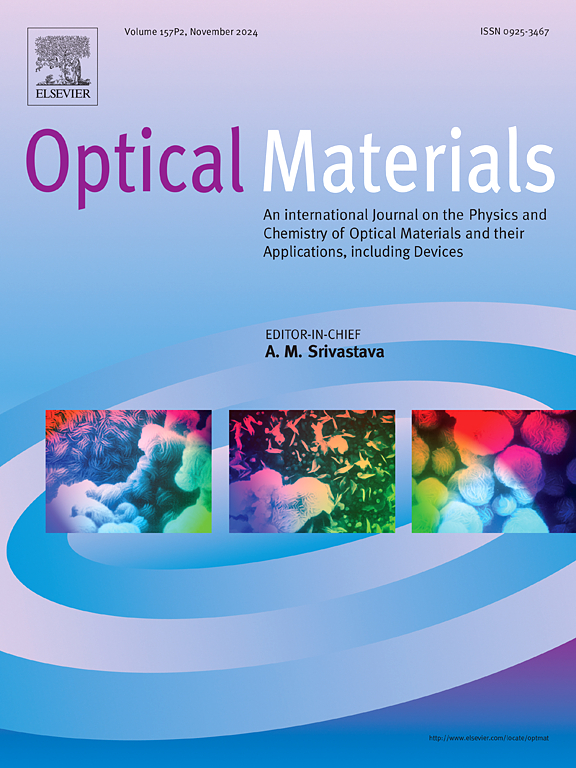Dynamic tunability of NIR absorption in a plasmonic grating through nonlinear kerr-effect of graphene-oxide and photothermal phase transition of GSST
IF 3.8
3区 材料科学
Q2 MATERIALS SCIENCE, MULTIDISCIPLINARY
引用次数: 0
Abstract
In this paper, we present an in-depth examination of the absorption dynamics of a silver plasmonic grating incorporating Kerr-type nonlinear graphene-oxide (GO) nanoslits and a Ge2Sb2Se4Te1 (GSST) phase-change material, both in linear and nonlinear regimes. Linear absorption approaches unity at the resonant wavelength when GSST is amorphous. Upon exposure to a nanosecond Gaussian pulse laser irradiation with appropriate fluences, the amorphous GSST partially crystallizes through a thermoplasmonic-induced process, resulting in a significant reduction of the linear on-resonance absorption in the form of a step-like curve. Additionally, the weak off-resonance linear absorption of the system can be enhanced owing to the non-uniform phase-transition within the GSST. Transitioning to a nonlinear regime, considering the third-order nonlinearity of GO nanoslits, reveals distinct absorption behaviors. Temporal analysis reveals that at the on-resonance wavelength, the unit absorption decreases with increasing laser intensity, reaching a minimum at the pulse peak due to the Kerr nonlinearity in the GO. Intriguingly, the absorption exhibits a U-shaped curve at lower fluences, while at higher fluences, it stabilizes at a lower value post-pulse peak where the amorphous GSST undergoes a thermally driven partially crystallization phase transformation. In the off-resonance mode, the weak absorption enhances dramatically by increasing the fluence, tracing an imperfect parabolic trajectory that reaches nearly unit at the trailing edge of the pulse, attributed to the Kerr nonlinearity within the GO nanoslits. By further increasing the laser fluence, the photothermal response of the GSST emerges as the dominant factor, diminishing the unity absorption observed at the trailing edge of the pulse. These findings underscore the dynamic responsiveness of the proposed grating to pulsed laser illumination, driven by the nonlinear Kerr effect and GSST reconfigurability, offering promising opportunities for developing active optical switching devices.
通过氧化石墨烯的非线性克尔效应和 GSST 的光热相变实现质子光栅中近红外吸收的动态可调性
在本文中,我们深入研究了一种银质光栅的吸收动态,该光栅包含了克尔型非线性氧化石墨烯(GO)纳米its 和 Ge2Sb2Se4Te1(GSST)相变材料,包括线性和非线性状态。当 GSST 为非晶态时,在谐振波长处的线性吸收接近于 1。在以适当流量照射纳秒高斯脉冲激光时,非晶态 GSST 会通过热致过程部分结晶,导致线性共振吸收以阶梯状曲线的形式显著降低。此外,由于 GSST 内部的非均匀相变,系统的弱离共振线性吸收也会增强。考虑到 GO 纳米its 的三阶非线性,过渡到非线性机制会显示出不同的吸收行为。时间分析表明,在共振波长处,由于 GO 中的克尔非线性,单位吸收随着激光强度的增加而减少,并在脉冲峰值处达到最小值。耐人寻味的是,在较低的通量下,吸收率呈现 U 型曲线,而在较高的通量下,吸收率稳定在脉冲峰值后的较低值上,此时非晶态 GSST 经历了热驱动的部分结晶相变。在非共振模式下,随着通量的增加,微弱的吸收显著增强,其轨迹呈不完全抛物线状,在脉冲后缘几乎达到单位,这归因于 GO 纳米its 内部的克尔非线性。通过进一步提高激光通量,GSST 的光热响应成为主导因素,从而减少了在脉冲后缘观察到的单位吸收。这些发现强调了在非线性克尔效应和 GSST 可重构性的驱动下,拟议光栅对脉冲激光照射的动态响应能力,为开发有源光学开关器件提供了大好机会。
本文章由计算机程序翻译,如有差异,请以英文原文为准。
求助全文
约1分钟内获得全文
求助全文
来源期刊

Optical Materials
工程技术-材料科学:综合
CiteScore
6.60
自引率
12.80%
发文量
1265
审稿时长
38 days
期刊介绍:
Optical Materials has an open access mirror journal Optical Materials: X, sharing the same aims and scope, editorial team, submission system and rigorous peer review.
The purpose of Optical Materials is to provide a means of communication and technology transfer between researchers who are interested in materials for potential device applications. The journal publishes original papers and review articles on the design, synthesis, characterisation and applications of optical materials.
OPTICAL MATERIALS focuses on:
• Optical Properties of Material Systems;
• The Materials Aspects of Optical Phenomena;
• The Materials Aspects of Devices and Applications.
Authors can submit separate research elements describing their data to Data in Brief and methods to Methods X.
 求助内容:
求助内容: 应助结果提醒方式:
应助结果提醒方式:


